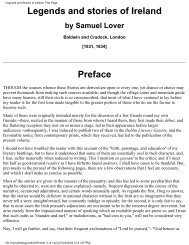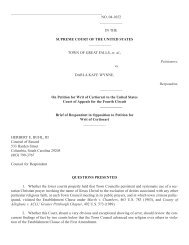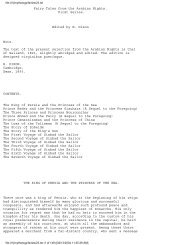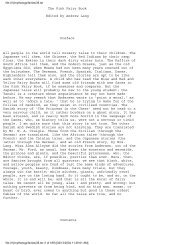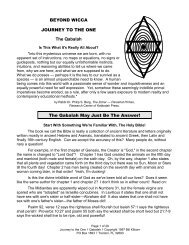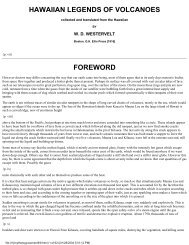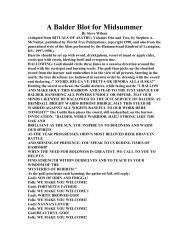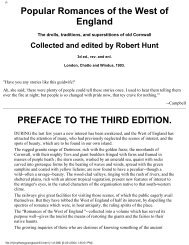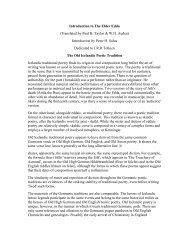Irish Druids And Old Irish Religions PREFACE CONTENTS
Irish Druids And Old Irish Religions PREFACE CONTENTS
Irish Druids And Old Irish Religions PREFACE CONTENTS
Create successful ePaper yourself
Turn your PDF publications into a flip-book with our unique Google optimized e-Paper software.
depositaries of the British Museum. It was the squatting figure of an<br />
p. 86<br />
exposed naked female, rudely sculptured, not unlike, except in size, the singular colossi under the Museum porch brought from Easter Isle.<br />
This figure was taken down from over the doorway of an ancient church in Ireland, and was, without doubt, a relic of pagan days, used<br />
during many Christian centuries to ward off evil from the incoming congregation. Another stood by the moat of Howth.<br />
In the Stone Chips of E. T. Steven we have the following--"The horse-shoe is still the conventional figure for the Yoni in Hindoo temples,<br />
and although its original import was lost, until lately the horse-shoe was held to be a charm against witchcraft and the evil eye amongst<br />
ourselves, precisely as was the case with the more unmistakable Shelah-na-Gig at certain churches in Ireland."<br />
The Dublin Museum contains an extraordinary bone-pin representing the Shelah-na-Gig and evidently a charm to shield the wearer. It was<br />
found alongside a skull in a field. Wilde declared that a Roscommon child was taken from the grave to obtain its arms for charm purposes.<br />
Popular holidays are still associated with the ideas of former heathen festivals.<br />
May-day in some parts of Ireland has its female mummers, who dance and hurl, wearing a holly-bush. A masked blown carries a pail of<br />
water with a mop for spreading its contents abroad. Boys then sing carols, as in France. In the south-east of Ireland a girl is chosen as May<br />
Queen, presiding at all May-makings till she is married. May Eve, having its dangers from fairies, &c., is spent in making cattle safe from<br />
the milk-thieving little people, by causing the cows to leap over fires. Dairymaids prudently drive their cows along with the mystical<br />
rowan stick.<br />
Of the phallic May-pole, set up for St. John's Eve or Midsummer-day, N. O'Kearney remarks, "The pole was<br />
p. 87<br />
evidently used in the Druidical ceremonies." Yule cakes were Nur cakes. Hogmanay was observed, as in Scotland. Hog was a Chaldaen<br />
festival. <strong>Irish</strong> pagan feasts were announced by the blowing of long horns, two or three yards in length, some of which are to be seen in<br />
Dublin Museum. The Christmas Candle of south-west Ireland was burnt till midnight on Christmas Eve, and the remnant kept as a<br />
preservative against evil spirits till the next year's candle was set up. Magic ointment revealed the invisible.<br />
All Saints' Day perpetuated the pagan Samhain of November Eve. Holy cakes, known sometimes as triangular bannocks, were then eaten<br />
as Soul-Mass cakes.<br />
"November Eve," says Mrs. Bryant's Celtic Ireland, "is sacred to the Spirits of the Dead. In the western islands the old superstition is<br />
dying very hard, and tradition is still well alive. It is dangerous to be out on November Eve, because it is the one night in the year when<br />
the dead come out of their graves to dance with the fairies on the hills, and as it is their night, they do not like to be disturbed."--"Funeral<br />
games are held in their houses." In olden times it was thought their dead heroes could help in distress.<br />
"Twice during the Treena of Tailten,<br />
Each day at sunrise I invoked Mac Eve<br />
To remove from me the pestilence."<br />
The Keens, or lamentations for the dead, are connected with ancient and heathenish practices. Professional howlers had charge of the<br />
corpse. Rich, who wrote in 1610 of a Keen, remarked, "A stranger at the first encounter would beleeve that a quantity of hags or hellish<br />
fiendes were carrying a dead body to some infernell mansion." But some of the Death Songs have great beauty of composition. Shelah<br />
Lea's Lament is a fine example. It is thus translated from the Erse:--<br />
"Sing the wild Keen of my country, ye whose heads<br />
p. 88<br />
bend in sorrow, in the house of the dead! Lay aside the wheel and flax, and sing not in joy, for there's a spare loft in my cabin! Oweneen,<br />
the pride of my heart, is not here! Did you not hear the cry of the Banshee crossing the lovely Kilcrumper? Or, was there a voice from the<br />
tomb, far sweeter than song, that whistled in the mountain wind, and told you that the young oak was fallen? Yes, he is gone! He has gone<br />
off in the spring of life, like the blossom of the prickly hawthorn, scattered by the merciless wind, on the cold clammy earth.--Raise the<br />
Keen, ye whose notes are well known, tell your beads, ye young women who grieve; lie down on his narrow house in mourning, and his<br />
spirit will sleep and be at rest! Plant the shamrock and wild firs near his head, that strangers may know who is fallen! Soon again will your<br />
Keen be heard on the mountain, for before the cold sod is sodded over the breast of my Oweneen, Shelah, the mother of Keeners, will be<br />
there. The voice, which before was loud and plaintive, will be still and silent, like the ancient harp of her country," &c.<br />
Another exclaimed:--"My sunshine you were. I loved you better than the sun itself; and when I see the sun going down in the west, I think<br />
of my boy, and my black night of sorrow. Like the rising sun, he had a red glow on his cheek. He was as bright as the sun at mid-day; but<br />
a dark storm came on, and my sunshine was lost to me for ever."<br />
No one would claim for the Keens a Christian origin. The Rev. John Wesley saw a funeral in 1750, and wrote:--"I was exceedingly<br />
shocked at the <strong>Irish</strong> howl which followed. It was not a song, but a dismal, inarticulate yell, set up at the grave by four shrill-voiced women<br />
file:///I|/mythology/witchcraft/8/8.html (32 of 114) [02/05/2004 8:38:14 AM]



